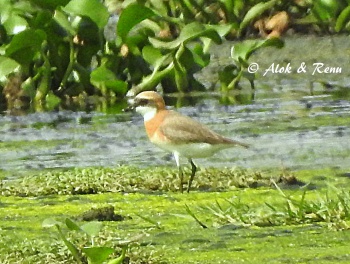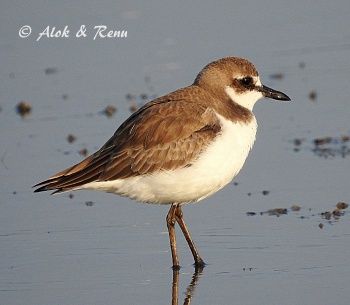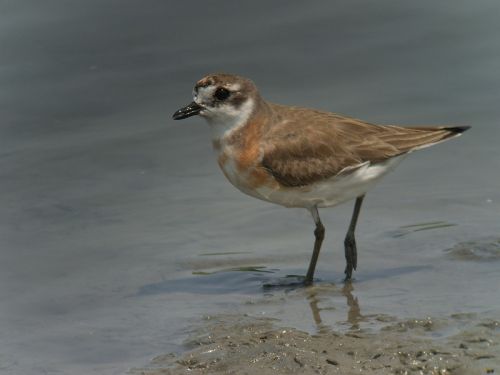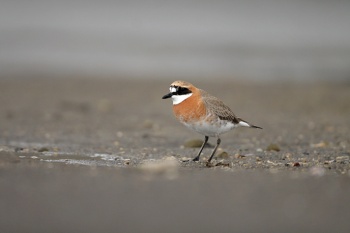Alternative name: Mongolian Plover
Includes: Tibetan Plover, Siberian Plover, Mongolian Plover
- Charadrius mongolus
Identification
18–21 cm (7-8¼ in)
- back brownish grey
- underparts white
- legs dark
- bill black
Breeding
- breast, forehead and nape chestnut
- eye mask black
The female is similar but duller
Winter and juvenile birds lack the chestnut
The two groups mentioned under taxonomy differ in several characters, such that a member of the mongolus group on average are larger than an atrifrons sand plover, and mongolus have mottled flanks where atrifrons have clean white flanks.
Similar Species
Distribution
Breeds in northern Asia. Winters in south Asia, Africa and Australia.
Vagrants have been recorded in Europe, America, and South America.
Taxonomy
Consistent differences between races lead some authorities to split subspecies into 2 species: "Mongolian Plover" or "Siberian Plover", C. mongolus including mongolus and stegmanni (larger eastern forms), and "Lesser Sand plover" (strict sense ) or "Tibetan Plover", C. atrifrons including atrifrons, pamirensis and schaeferi.
Subspecies

Photo © by Alok Tewari
Nazafgarh Marshes, Delhi-Gurgaon Border, India, May-2017

Photo © by Alok Tewari
Jamnagar, Coastal Gujarat, India, Jan-2016
Clements recognises the following subspecies [1]:
- C. m. pamirensis: "Lesser Sandplover (strict sense)". Pamirs to western China (western Xinjiang); winters to Africa and western India
- C. m. atrifrons "Lesser Sandplover (strict sense)". Himalayas and southern Tibet: winters from India to Sumatra
- C. m. schaeferi: "Lesser Sandplover (strict sense)". Eastern Tibet to southern Mongolia; winters Thailand to Greater Sundas
- C. m. mongolus: "Mongolian Plover". Eastern Siberia and Russian Far East; winters Taiwan to Australia
- C. m. stegmanni: "Mongolian Plover". Kamchatka to Chukotsk Peninsula; winters to Australia
Habitat
Coastal shores, mudflats and fields
Behaviour
Breeding
They nest in a bare ground scrape; the clutch consists of 3 eggs.
Diet
Their varied diet includes insects, crustaceans, such as crabs and molluscs and annelid worms on their non-breeding grounds. What they eat during the breeding season is not well recorded.
Vocalisation
Flight call: A hard trill.
References
- Clements, J. F., T. S. Schulenberg, M. J. Iliff, S. M. Billerman, T. A. Fredericks, B. L. Sullivan, and C. L. Wood. 2019. The eBird/Clements Checklist of Birds of the World: v2019. Downloaded from http://www.birds.cornell.edu/clementschecklist/download/
- Collins Bird Guide ISBN 0 00 219728 6
- Thread in Birdforum Id forum discussing Lesser vs Greater Sand Plover identification
- Wiersma, P., Kirwan, G.M., Christie, D.A. & Boesman, P. (2020). Lesser Sandplover (Charadrius mongolus). In: del Hoyo, J., Elliott, A., Sargatal, J., Christie, D.A. & de Juana, E. (eds.). Handbook of the Birds of the World Alive. Lynx Edicions, Barcelona. (retrieved from https://www.hbw.com/node/53845 on 3 March 2020)
Recommended Citation
- BirdForum Opus contributors. (2024) Siberian Sand Plover. In: BirdForum, the forum for wild birds and birding. Retrieved 4 May 2024 from https://www.birdforum.net/opus/Siberian_Sand_Plover
External Links
GSearch checked for 2020 platform.1






